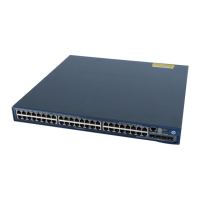80
Enabling the output of port state transition information
A large-scale, MSTP-enabled network can have many MSTIs, and ports might frequently transition from
one state to another. In this situation, you can enable devices to output the port state transition
information of all MSTIs or the specified MSTI in order to monitor the port states in real time.
Make this configuration separately on the root bridge and on the leaf nodes.
Follow these steps to enable output of port state transition information:
Enable output of port state
transition information
stp port-log { all | instance
instance-id }
Required
Enabled by default.
Enabling the MSTP feature
You must enable MSTP for the device before any other MSTP-related configurations can take effect.
Make this configuration on the root bridge and on the leaf nodes separately.
Follow these steps to enable the MSTP feature:
Enable the MSTP feature globally
Required
MSTP is globally disabled by
default.
Enter interface
view or port
group view
Enter Ethernet
interface view or
Layer 2 aggregate
interface view
interface interface-type
interface-number
Required
Use either command.
port-group manual port-group-
name
Enable the MSTP feature for the ports
Optional
By default, MSTP is enabled for
all ports after it is enabled for
the device globally.
NOTE:
In system view, you can use the stp enable or undo stp enable command to enable or disable STP globally.
You can use the undo stp enable command to disable the MSTP feature for certain ports so that they will not
participate in spanning tree calculation to save the CPU resources of the device.
Performing mCheck
MSTP has three working modes: STP compatible mode, RSTP mode, and MSTP mode.

